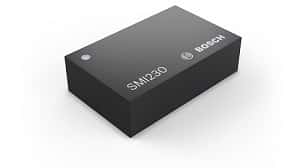- Bosch’s new sensor features continuous support of data from GNSS even during low signal reception
- Also suitable as motion detectors for applications such as fleet management and toll systems
 In order to avoid failure of the vehicle navigation system while venturing into unfamiliar territory, say an unknown city or road, Bosch has now introduced a MEMS sensor, the SMI230. This highly precise sensor constantly registers changes in the vehicle’s direction and speed, evaluates the information and transmits it to the navigation system. There, the information is combined with the positional data from the global navigation satellite system (GNSS) and used for navigation.
In order to avoid failure of the vehicle navigation system while venturing into unfamiliar territory, say an unknown city or road, Bosch has now introduced a MEMS sensor, the SMI230. This highly precise sensor constantly registers changes in the vehicle’s direction and speed, evaluates the information and transmits it to the navigation system. There, the information is combined with the positional data from the global navigation satellite system (GNSS) and used for navigation.
Sudden interruptions in the GPS signal due to an overhead tunnel while driving can cause disarray in the navigation system. However, the SMI230 ensures a vehicle’s navigation system is free from such issues. “When the navigation system is at a loss, Bosch semiconductor sensors ensure that the car doesn’t lose its way,” says Jens Fabrowsky, member of the executive management of Bosch’s Automotive Electronics division.
Thanks to the combination of GPS position and sensor information, the navigation arrow on the display no longer makes unrealistic jumps or suddenly changes orientation on its path.
Constant motion detection
To generate high-precision data of vehicle motion, two tiny, MEMS sensors – one for the vehicle’s acceleration and the other for its yaw rate – have been housed into a single IC. The strength of the SMI230 lies in this combination. Also, the sensor duo achieves an extraordinary degree of precision and can detect changes in the vehicle’s motion unusually quickly.
Thanks to the data from the SMI230 sensor, the map display moves smoothly along with the vehicle’s motion. The same also applies to a situation when the navigation system completely loses its orientation due to a weak satellite signal. “Bosch’s sensor resolves the blind spots of GNSS navigation,” says Michael Rupp, product manager in Automotive Electronics at Bosch. “It helps to precisely determine the vehicle’s position, even with a weak satellite signal and to provide directions at just the right time for proceeding along the route.” To accomplish this, the navigation system constantly analyzes changes in vehicle direction and speed as detected by the SMI230 and transmits the vehicle’s position to the navigation map. The data acquisition is so precise that the display of the vehicle’s position remains reliable even if the dropped signal persists for some time.
One sensor, many possibilities
Bosch semiconductor chips are not only used as sensors for safety and driver assistance systems but also in multimedia and connectivity applications as well as in conventional and electrified powertrains. The capabilities of the SMI230 MEMS sensor not just improve navigation, but also make it ideal for use as precise motion detectors in fleet management and toll systems. Furthermore, the sensor is suited for use in vehicle alarm systems because of its ability to detect vibrations and impacts. If there is an accident, the sensor data can still trigger the automatic eCall emergency call system.
“Semiconductors are key to modern-day mobility and it is impossible to imagine cars today without them,” Fabrowsky says. Bosch has recently started the production of the SMI230.











